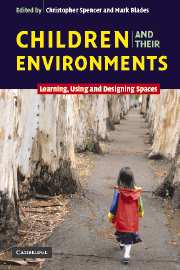Book contents
- Frontmatter
- Contents
- Notes on contributors
- An introduction
- Part I Children's understanding of places
- Part II Children's experience of places
- 5 Learning neighbourhood environments: the loss of experience in a modern world
- 6 The classroom environment and children's performance – is there a relationship?
- 7 ‘Sometimes birds sound like fish’: Perspectives on children's place experiences
- 8 Is contact with nature important for healthy child development? State of the evidence
- 9 Environmental child-friendliness in the light of the Bullerby Model
- Part III Adolescents' worlds?
- Part IV Children and the design process
- Index
- References
9 - Environmental child-friendliness in the light of the Bullerby Model
Published online by Cambridge University Press: 23 October 2009
- Frontmatter
- Contents
- Notes on contributors
- An introduction
- Part I Children's understanding of places
- Part II Children's experience of places
- 5 Learning neighbourhood environments: the loss of experience in a modern world
- 6 The classroom environment and children's performance – is there a relationship?
- 7 ‘Sometimes birds sound like fish’: Perspectives on children's place experiences
- 8 Is contact with nature important for healthy child development? State of the evidence
- 9 Environmental child-friendliness in the light of the Bullerby Model
- Part III Adolescents' worlds?
- Part IV Children and the design process
- Index
- References
Summary
In this chapter I present a hypothetical model of a child-friendly environment, based on the covariation of opportunities for independent mobility and the actualization of affordances. I have named this model a ‘Bullerby-model’, according to the ideal circumstances where children enjoy sufficient possibilities to move around independently in the environment and to perceive the environment as a rich source of affordances.
‘Bullerby’ can be literally translated as a noisy village. It is used by the famous Swedish writer Astrid Lindgren in her children's novels where she describes the life of a group of children living in a Swedish village. I chose this label for the ideal situation of a child-friendly environment because ‘Bullerby’ offers children possibilities to take part in all everyday activities of a village and it provides children with important roles and responsibilities in the community. With the ‘Bullerby’ label I don't want to claim that a rural village setting can be the only candidate for a child-friendly environment. Any ‘normal’ everyday environment that does not exclude children can be child-friendly.
The presented model is a theoretical tool for assessing the child friendliness of various settings. ‘Bullerby’ – type of environments can have many different appearances, in both rural, suburban, and urban settings. I have used this interpretative model to assist in comparing data from four Finnish and five Belarussian neighbourhoods of various levels of urbanization (Kyttä, 2003, 2004). Further empirical testing can validate the model for other countries and different settings.
- Type
- Chapter
- Information
- Children and their EnvironmentsLearning, Using and Designing Spaces, pp. 141 - 158Publisher: Cambridge University PressPrint publication year: 2006
References
- 29
- Cited by



